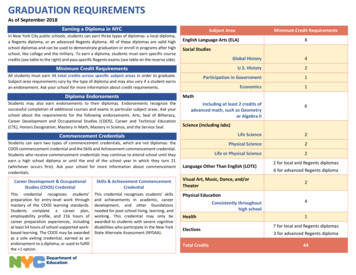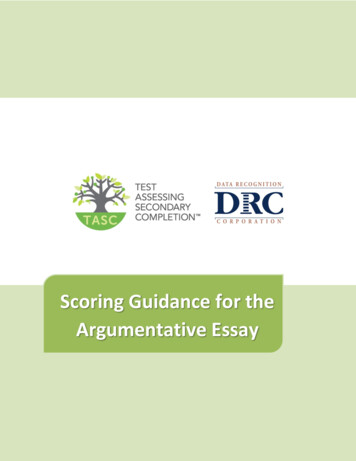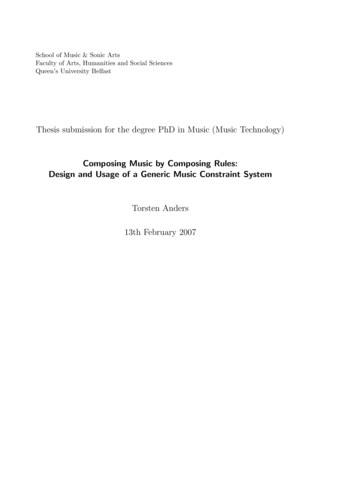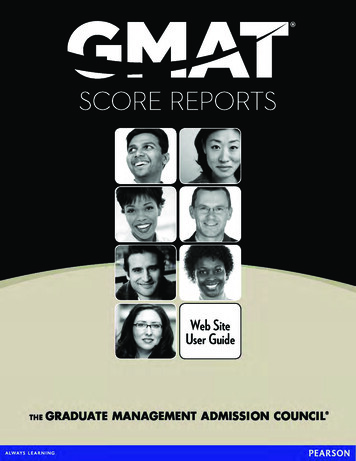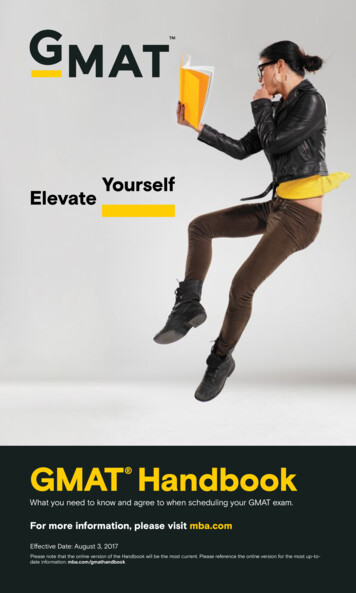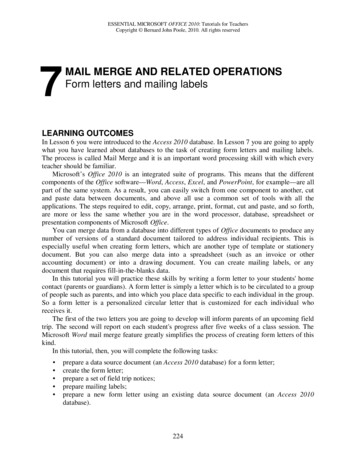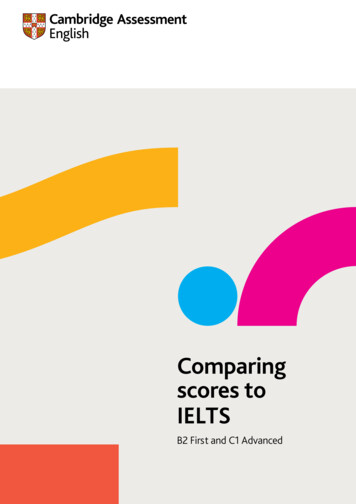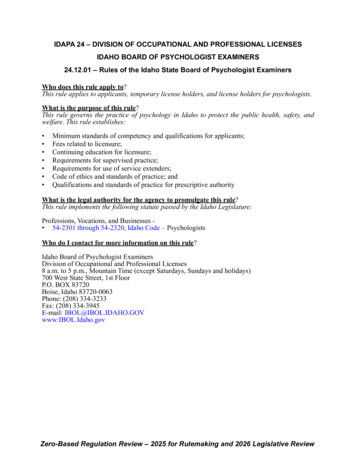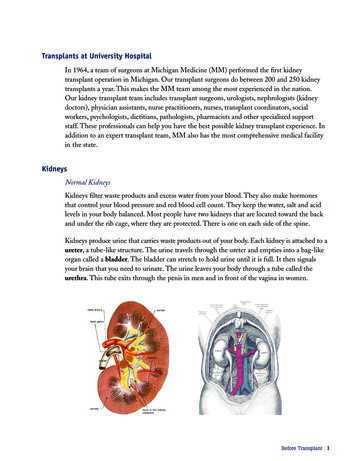
Transcription
STUDENT NAME:STUDENT SCORE:MISSISSIPPI ASSESSMENT PROGRAM (MAP)ENGLISH LANGUAGE ARTSPRACTICE TESTLETGRADE 7Carey M. Wright, Ed.D., State Superintendent of EducationJ.P. Beaudoin, Ed.D., Chief Research and Development OfficerMarch 2016
A Joint PublicationDivision of Research and Development, Office of Student Assessment Dr. J.P. Beaudoin, Chief Research and Development OfficerWalt Drane, Director of Operations and Test SecurityMarion Jones, Director of Support ServicesRichard Baliko, NAEP State CoordinatorSharon Prestridge, Special Populations CoordinatorVincent Segalini, MAP Program CoordinatorPatrice Williams, MKAS CoordinatorOffice of the Chief Academic Officer Dr. Kim Benton, Chief Academic OfficerJean Massey, Executive Director, Office of Secondary EducationNathan Oakley, Executive Director, Office of Elementary Education and ReadingTrudy Cook, Lead Professional Development CoordinatorVictoria Johnson, Office Director ELADr. Kymyona Burk, State Literacy DirectorDana Danis, ELA Professional Development CoordinatorFelicia Jackson-Stewart, ELA Professional Development CoordinatorThe Mississippi State Board of Education, the Mississippi Department of Education, theMississippi School for the Arts, the Mississippi School for the Blind, the Mississippi School forthe Deaf, and the Mississippi School for Mathematics and Science do not discriminate on thebasis of race, sex, color, religion, national origin, age, or disability in the provision ofeducational programs and services or employment opportunities and benefits. The followingoffice has been designated to handle inquiries and complaints regarding the non-discriminationpolicies of the above-mentioned entities:Director, Office of Human ResourcesMississippi Department of Education359 North West StreetSuite 203Jackson, Mississippi 39201(601) 359-3511MAP TESTLET-ELA-GRADE 7MISSISSIPPI DEPARTMENT OF EDUCATION 1
IntroductionPurposeThe practice testlet is designed to provide students with an authentic opportunity topractice items that are aligned to the Mississippi College- and Career-Readiness Standards andthat mirror those that will appear on the ELA MAP assessment. The testlet is also intended toprovide teachers with data to drive classroom instruction and provide direct feedback to students.It is NOT intended to predict student performance on the operational MAP assessment.StructureThe ELA testlet is formatted as a true performance task. There is a passage and writingprompt. The writing prompt was written to measure reading, writing, and language MS CCRS.Students will read the passage and answer a series of multiple-select items. These multiple-selectitems will help the students unpack the text and develop their thinking for the writing task.Directions1. Allow students to read the text, complete the multiple-select items, and the writingtask. Teachers should follow the MAP Testing Time Guidance for the writing tasks.2. Teachers will review student responses to the multiple-select items and score thewriting tasks using the MAP Writing Rubric.3. Teachers should review the results to determine the needed instructional approach(reteaching).4. Teachers can utilize the testlets as teaching tools to help students gain deeperunderstanding of the MS CCRS.5. The writing tasks and the scored responses can be used as models for future studentwriting.6. At the bottom left of each page is an item tag, which will contain the item number,grade level, suggested DOK level, and the standard aligned to the item.MAP TESTLET-ELA-GRADE 7MISSISSIPPI DEPARTMENT OF EDUCATION 2
DIRECTIONSRead the passage. Then read the questions about the passage. Choose the best answer and mark it inthis test book.Excerpt from The Call of the Wildby Jack London1Buck did not read the newspapers, or he would have known that trouble wasbrewing, not alone for himself, but for every tide-water dog, strong of muscle andwith warm, long hair, from Puget Sound to San Diego. Because men, groping inthe Arctic darkness, had found a yellow metal, and because steamship andtransportation companies were booming the find, thousands of men were rushinginto the Northland. These men wanted dogs, and the dogs they wanted were heavydogs, with strong muscles by which to toil, and furry coats to protect them from thefrost.2Buck lived at a big house in the sun-kissed Santa Clara Valley. JudgeMiller's place, it was called. It stood back from the road, half hidden among thetrees, through which glimpses could be caught of the wide cool veranda that ranaround its four sides. The house was approached by gravelled driveways whichwound about through wide-spreading lawns and under the interlacing boughs oftall poplars. At the rear things were on even a more spacious scale than at the front.There were great stables, where a dozen grooms and boys held forth, rows of vineclad servants' cottages, an endless and orderly array of outhouses, long grapearbors, green pastures, orchards, and berry patches. Then there was the pumpingplant for the artesian well, and the big cement tank where Judge Miller's boys tooktheir morning plunge and kept cool in the hot afternoon.MAP TESTLET-ELA-GRADE 7MISSISSIPPI DEPARTMENT OF EDUCATION 3
3And over this great demesne Buck ruled. Here he was born, and here he hadlived the four years of his life. It was true, there were other dogs. There could notbut be other dogs on so vast a place, but they did not count. They came and went,resided in the populous kennels, or lived obscurely in the recesses of the houseafter the fashion of Toots, the Japanese pug, or Ysabel, the Mexican hairless,—strange creatures that rarely put nose out of doors or set foot to ground. On theother hand, there were the fox terriers, a score of them at least, who yelped fearfulpromises at Toots and Ysabel looking out of the windows at them and protected bya legion of housemaids armed with brooms and mops.4But Buck was neither house-dog nor kennel-dog. The whole realm was his.He plunged into the swimming tank or went hunting with the Judge's sons; heescorted Mollie and Alice, the Judge's daughters, on long twilight or early morningrambles; on wintry nights he lay at the Judge's feet before the roaring library fire;he carried the Judge's grandsons on his back, or rolled them in the grass, andguarded their footsteps through wild adventures down to the fountain in the stableyard, and even beyond, where the paddocks were, and the berry patches. Amongthe terriers he stalked imperiously, and Toots and Ysabel he utterly ignored, for hewas king,—king over all creeping, crawling, flying things of Judge Miller's place,humans included.5His father, Elmo, a huge St. Bernard, had been the Judge's inseparablecompanion, and Buck bid fair to follow in the way of his father. He was not solarge,—he weighed only one hundred and forty pounds,—for his mother, Shep,had been a Scotch shepherd dog. Nevertheless, one hundred and forty pounds, towhich was added the dignity that comes of good living and universal respect,enabled him to carry himself in right royal fashion. During the four years since hispuppyhood he had lived the life of a sated aristocrat; he had a fine pride in himself,was even a trifle egotistical, as country gentlemen sometimes become because ofMAP TESTLET-ELA-GRADE 7MISSISSIPPI DEPARTMENT OF EDUCATION 4
their insular situation. But he had saved himself by not becoming a mere pamperedhouse-dog. Hunting and kindred outdoor delights had kept down the fat andhardened his muscles; and to him, as to the cold-tubbing races, the love of waterhad been a tonic and a health preserver.6And this was the manner of dog Buck was in the fall of 1897, when theKlondike strike dragged men from all the world into the frozen North. But Buckdid not read the newspapers, and he did not know that Manuel, one of thegardener's helpers, was an undesirable acquaintance. Manuel had one besetting sin.He loved to play Chinese lottery. Also, in his gambling, he had one besettingweakness—faith in a system; and this made his damnation certain. For to play asystem requires money, while the wages of a gardener's helper do not lap over theneeds of a wife and numerous progeny.7The Judge was at a meeting of the Raisin Growers' Association, and the boyswere busy organizing an athletic club, on the memorable night of Manuel'streachery. No one saw him and Buck go off through the orchard on what Buckimagined was merely a stroll. And with the exception of a solitary man, no one sawthem arrive at the little flag station known as College Park. This man talked withManuel, and money chinked between them.8"You might wrap up the goods before you deliver 'm," the stranger saidgruffly, and Manuel doubled a piece of stout rope around Buck's neck under thecollar.9"Twist it, an' you'll choke 'm plentee," said Manuel, and the stranger grunteda ready affirmative.10 Buck had accepted the rope with quiet dignity.MAP TESTLET-ELA-GRADE 7MISSISSIPPI DEPARTMENT OF EDUCATION 5
1. Which two phrases from the passage support the inference that Buck wasconceited?a. “These men wanted dogs” (paragraph 1)b. “there were other dogs” (paragraph 3)c. “he utterly ignored” (paragraph 4)d. “in the way of his father” (paragraph 5)e. “he had a fine pride in himself” (paragraph 5)01-GR7-LV2-RL.7.1MAP TESTLET-ELA-GRADE 7MISSISSIPPI DEPARTMENT OF EDUCATION 6
2. How does the personification of Buck convey meaning in the passage?a. It draws a parallel between the Judge and Buck.b. It reveals the tension between Buck and Manuel.c. It shows the contrast between Buck and the other dogs.d. It provides a deeper understanding of Buck’s point of view.02-GR7-LV3-RL.7.4MAP TESTLET-ELA-GRADE 7MISSISSIPPI DEPARTMENT OF EDUCATION 7
3. How does the word sun-kissed as used in paragraph 2 impact themeaning of the passage?a. It describes the brightness of the yellow metal.b. It provides an understanding of the Buck’s disposition.c. It shows a contrast between Buck’s home and the Northland.d. It illustrates the difference in Buck’s home and Judge Miller’s home.03-GR7-LV3-RL.7.4MAP TESTLET-ELA-GRADE 7MISSISSIPPI DEPARTMENT OF EDUCATION 8
4. Read this sentence from paragraph 4 and answer the question thatfollows.Among the terriers he stalked imperiously, and Toots and Ysabel heutterly ignored, for he was king,—king over all creeping, crawling,flying things of Judge Miller's place, humans included.What does this sentence reveal about Buck?a. Buck has strong leadership skills.b. Buck needs to dominate to be happy.c. Buck enjoys intimidating Toots and Ysabel.d. Buck views himself as the most powerful one.04-GR7-LV2-RL.7.3MAP TESTLET-ELA-GRADE 7MISSISSIPPI DEPARTMENT OF EDUCATION 9
5. In paragraph 1, how does the description of the men in the north impactthe rest of the passage?a. It provides a solution to Manuel’s problem.b. It gives a reason why Buck trusts Manuel.c. It explains Buck’s behavior towards the other dogs.d. It exposes the truth about the Judge and his family.05-GR7-LV2-RL.7.3MAP TESTLET-ELA-GRADE 7MISSISSIPPI DEPARTMENT OF EDUCATION 10
6. Read this sentence from paragraph 1 and paragraph 6 and answer thequestion that follows.Buck did not read the newspapers What is the author’s purpose for repeating this sentence in bothparagraphs?a. to emphasize how powerless Buck isb. to emphasize how irresponsible Buck isc. to emphasize how informed Buck isd. to emphasize how blameless Buck is06-GR7-LV2-RL.7.4MAP TESTLET-ELA-GRADE 7MISSISSIPPI DEPARTMENT OF EDUCATION 11
7. What is the author’s purpose for including the explanation of Manuel’s“one besetting sin”?a. to show that Manuel had a gambling problemb. to reveal a reason for Buck not liking Manuelc. to explain why Manuel enjoys taking Buck on walksd. to supply Manuel’s motive for trading Buck for money07-GR7-LV2-RL.7.6MAP TESTLET-ELA-GRADE 7MISSISSIPPI DEPARTMENT OF EDUCATION 12
8. This item has two parts. First answer Part A. Then answer Part B.Part AWhich statement best reflects a theme of the passage?a. People are not trustworthy.b. Knowledge is the key to happiness.c. Pride is more dangerous than it appears.d. Loved ones cause more pain than strangers.Part BSelect two sentences that highlight the development of this themethroughout the passage.a. “It was true, there were other dogs. There could not but be other dogson so vast a place, but they did not count.” (paragraph 3)b. “Among the terriers he stalked imperiously, and Toots and Ysabel heutterly ignored, for he was king,—king over all ” (paragraph 4)c. “Hunting and kindred outdoor delights had kept down the fat andhardened his muscles ” (paragraph 5)d. “Manuel had one besetting sin. He loved to play Chinese lottery ”(paragraph 6)e. “The Judge was at a meeting of the Raisin Growers' Association, andthe boys were busy organizing an athletic club ” (paragraph 7)f. “Buck had accepted the rope with quiet dignity.” (paragraph 10)08-GR7-LV2-RL.7.2MAP TESTLET-ELA-GRADE 7MISSISSIPPI DEPARTMENT OF EDUCATION 13
Writing Prompt9. You have read an excerpt from The Call of the Wild. Write an essay thatanalyzes how the author uses Buck’s character traits to develop a theme.Use key details and examples from the passage to support your ideas.Your writing will be scored on the development of ideas, organization ofwriting, and language conventions of grammar, usage, and mechanics.09-GR7-LV3-RL.7.2, W.7.2, L.7.1-3MAP TESTLET-ELA-GRADE 7MISSISSIPPI DEPARTMENT OF EDUCATION 14
MAP TESTLET-ELA-GRADE 7MISSISSIPPI DEPARTMENT OF EDUCATION 15StandardDevelopmentof IdeasStandard IDW.7.1-3Performance Range3 pointsThe writing isgenerally clear andfocused, and shows ageneralunderstanding of thegiven task. Ideas areadequately developedby using logicalreasoning, sufficientand appropriateevidence from thetext, and descriptionsand details that are,for the most part,relevant and accuratebased upon the text.The writing is clear,consistently focused,and shows a completeunderstanding of thegiven task. Ideas arefully developed byusing logical andconvincing reasoning,well-chosen evidencefrom the text, anddetails that arespecific, relevant, andaccurate based uponthe text.Proficient11-94 pointsAdvanced12The writing is vagueand shows onlypartial understandingof the given task.Ideas are somewhatdeveloped by usingsome reasoning andsome evidence fromthe text anddescriptions anddetails that may beirrelevant, may bemerely listed, andmay or may not befound in the text.Score of2 pointsBasic8-5English Language Arts Writing RubricThe writing isunclear, and shows alack of understandingof the given task.Ideas are developedwith limitedreasoning, little to noevidence from thetext, and descriptionsand details that areirrelevant and/orinaccurate.1 pointMinimal4-1The writing isunclear, shows nounderstanding of thegiven task, and usesno reasoning withlittle to no evidencefrom the text anddescriptions anddetails that areirrelevant and/orinaccurate.0 points0
MAP TESTLET-ELA-GRADE 7MISSISSIPPI DEPARTMENT OF EDUCATION 16StandardWritingOrganizationStandard IDW.7.1-33 pointsThe writingdemonstratesevidence of planningand a progression ofideas that allows thereader to follow thewriter’s ideas. Words,clauses, andtransitions are usedeffectively to clarifythe relationshipsamong claims,reasons, details,and/or evidence. Thewriting contains anintroduction andconclusion thatcontribute to thecohesiveness of theresponse.4 pointsThe writingdemonstratesevidence of planningand a purposeful,logical progression ofideas that allows thereader to easilyfollow the writer’sideas. Words,clauses, andtransitions are usedfrequently andeffectively to clarifythe relationshipsamong claims,reasons, details,and/or evidence. Thewriting contains aneffective introductionand conclusion thatcontribute tocohesiveness andclarity of theresponse.The writingdemonstratesevidence of planningwith some logicalprogression of ideasthat allows the readerto follow the writer’sideas. Words,clauses, andtransitions are usedsomewhatconsistently to clarifythe relationshipsamong claims,reasons, details,and/or evidence. Thewriting contains abasic introductionand conclusion thatcontribute tocohesiveness thatmay be formulaic instructure.Score of2 points1 pointThe writing shows anattempt at planning,but the progression ofideas is not alwayslogical, making itmore difficult for thereader to follow thewriter’s message orideas. Words,clauses, andtransitions are usedsparingly andsometimesineffectively toclarify therelationships amongclaims, reasons,details, and/orevidence. The writingcontains anintroduction andconclusion that areinappropriate and/ordisconnected,resulting in a lack ofcohesiveness andclarity.0 pointsThe writing lacksevidence of planning(random order) or aprogression of ideas,making it difficult forthe reader to followthe writer’s messageor ideas. Words,clauses, andtransitions are lackingor used ineffectivelyto clarify therelationships amongclaims, reasons,details, and/orevidence. There is alack of anintroduction and/orconclusion resultingin a lack ofcohesiveness andclarity.
MAP TESTLET-ELA-GRADE 7MISSISSIPPI DEPARTMENT OF EDUCATION 17StandardLanguageConventionsof Grammarand UsageLanguageConventionsof MechanicsStandard IDL.7.1 and 7.3L.7.24 points3 pointsThe writingdemonstrates aninconsistentcommand of theconventions ofstandard English(punctuation,capitalization,spelling). The writingmay contain a patternof errors inmechanics thatoccasionally impedesmeaning.The writingdemonstrates aconsistent commandof the conventions ofstandard English(punctuation,capitalization,spelling). The writingmay contain a fewminor errors inmechanics but theydo not interfere withmeaning.1 pointThe writing maintainsa tone inappropriateto task, purpose,and/or audience.Word choice islimited, clichéd, andrepetitive. Sentencesshow little or novariety in length andstructure, and somemay be awkwardleading to amonotonous reading.The writing maycontain a pattern oferrors in grammarand usage thatoccasionally impedesmeaning.The writingestablishes andmaintains toneappropriate to task,purpose, andaudience. Wordchoice is precise,effective, andpurposeful. Sentencesare fluent and variedin length andstructure. Thewriting may containa few minor errors ingrammar and usage,but they do notinterfere withmeaning.Score of2 points0 pointsThe writing fails tomaintain toneappropriate to task,purpose, andaudience. Words arefunctional and simpleand/or may beinappropriate to thetask. The sentencesmay contain errors inconstruction or aresimple and lackvariety, making theessay difficult toread. The writingmay containegregious errors ingrammar and usagethat impedemeaning.The writingdemonstrates verylimited command ofthe conventions ofstandard English(punctuation,capitalization,spelling). The writingmay containegregious errors inmechanics thatimpede meaning.
Answer KeyItemAnswerStandardPoint Value1C, .417DRL.7.618C; A, BRL.7.229Answers will varyRL.7.2, W.7.2, L.7.1-123Total Point Value22Scoring RulesStep #1: Items #1-7are selected-response items worth 1 point each, for a total of 7 points.Step #2: Items #1 and #8 are 2-point items. In Item # 1, students must get both answers correct to earnboth points and 1of 2 answers correct to earn 1 point. In Item #8, students must answerboth parts correctly to receive 2 points. They must answer Part A correctly to receive 1point.Step #3: Item #9 is a constructed-response item worth 12 total points (See Writing Rubric).Step #4: Add the total points earned by the student in steps #1-3.Step #5: Divide the total points in step #4 by the total available points.Step #6: Determine if the student earned at least 80% of the total points.Readability Metric11Word CountLexile LevelFlesch-Kincaid Level90611208.8See Mississippi Assessment Program (MAP) Blueprint Interpretive Guide for grade specific guidelines.MAP TESTLET-ELA-GRADE 7MISSISSIPPI DEPARTMENT OF EDUCATION 18
house-dog. Hunting and kindred outdoor delights had kept down the fat and hardened his muscles; and to him, as to the cold-tubbing races, the love of water had been a tonic and a health preserver. 6 And this was the manner of dog Buck was in the fall of 1897, when the Klondike strike dragged men from all the world into the frozen North. But Buck



